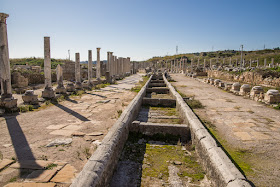Yes, another ancient city, and an important one, and of course not the last one. You might think we are obsessed with ancient cities. Maybe! But every one of them surprises us again, with their size, their luxury, their standard of living at a time when in Central Europe we were still sitting around the fire place living in wooden huts.
 |
| Detail of the marble panelling at the stage of the theatre |
Perge was an ancient Greek city in Anatolia, once the capital of Pamphylia Secunda, the area of todays Antalya province. But the city is of earlier origin, an acropolis located there dates back to the Bronze Age and the Hittites.
Alexander the Great occupied Perge with a part of his army. Alexander's rule was followed by the Seleucids, then the Romans.
According to the Acts of the Apostles, St. Paul journeyed to Perge in 46 A.D. and returned later when he preached the word of God (Acts 14:25).
In the first half of the 4th century, during the reign of Constantine the Great (324-337), Perge became an important centre of Christianity, which soon became the official religion of the Roman Empire. The city retained its status as a Christian centre in the 5th and 6th centuries.
 |
| Hellenistic city gate |
 |
| Agora |
 |
| Colonnaded street with a water basin |
 |
| Part of a gymnasium |
 |
Nymphaeum with the lying figure of the river god Kestros
under him the water emerged and filled the basins along the main road |
 |
| 20 m wide column-lined street with water flowing in the centre |
 |
| Carefully marked and reassembled again |
 |
| Ancient Roman floor mosaic of Agamemnon |
 |
| Marble stone at the agora |
 |
| Thick marble panelling at the entrance gate |
 |
| Cart wheels have left their marks in the road |
 |
| Roman bath with underfloor heating |
 |
| Roman bath |
 |
| Caldarium in the Roman bath |
 |
| Mosaic floor of the bath |
 |
| Impressive stadium in good condition |
The well-preserved U-shaped stadium had 15.000 seats and 50 vaults, which carried the rows of seats. Some of the vaults served as shops, every third as access. It was once the largest in Asia Minor, being 234 m long and 34 m wide. Can you imagine it full of citizens cheering the naked! runners? For sure there were vendors selling refreshments too. I imagine they also did races with horses and carriages there?
 |
| Stadium vaults from the outside |
 |
| Starting point or entrance to the stadium |
 |
| Marble relief at the theatre stage |
 |
| Stage building of the theatre |
The ancient theater of Perge had seats for 14,000 spectators and is one of the largest of its kind. Half of the stage building has been preserved. You can still see parts of the earlier decoration with marble friezes and reliefs, wall cladding and niches with statues. The reliefs show amongst others the battle of the giants and some centaurs.
 |
| Theatre for 14.000 spectators |
 |
| Fencing carved from stone to protect the spectators from the wild animals |
 |
| One of many niches for statues at the stage |
 |
| Marble panelling covered all of the building |
 |
| How might it have been to be one of the spectators? |
































